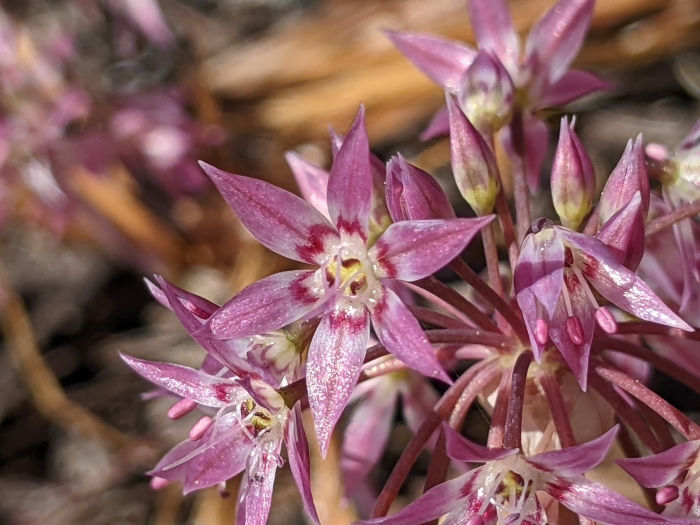Dusky Onion
(Allium campanulatum)
Dusky Onion (Allium campanulatum)
/
/

Ken-ichi Ueda
CC BY 4.0
Image By:
Ken-ichi Ueda
Recorded By:
Copyright:
CC BY 4.0
Copyright Notice:
Photo by: Ken-ichi Ueda | License Type: CC BY 4.0 | License URL: http://creativecommons.org/licenses/by/4.0/ | Rights Holder: Ken-ichi Ueda | Publisher: iNaturalist | Date Created: 2022-06-26T08:19:59-07:00 |






















Estimated Native Range
Summary
Allium campanulatum, commonly known as dusky onion or Sierra onion, is a perennial herb native to the western United States, specifically from southeastern Washington to southern California and western Nevada. It is typically found in a variety of habitats including open woodlands, grasslands, and dry, rocky slopes in foothills and mountains. This species is adapted to well-drained soils and is often seen in areas with a Mediterranean climate characterized by wet winters and dry summers.
The dusky onion grows from a gray-brown bulb and produces a stout stem up to 40 centimeters tall, with usually two long, thin leaves that wither by the time of flowering. The inflorescence is an umbel containing 10 to 50 flowers, which can be pink, purple, or white with a dark-colored base, and are quite showy when they bloom from May to August. The flowers are attractive to a variety of pollinators, including bees and butterflies. In cultivation, dusky onion is valued for its drought tolerance and its ability to add color to rock gardens, native plant gardens, and wildflower meadows. It requires little maintenance once established and thrives in full sun to part shade with low water needs, making it suitable for xeriscaping. It is not commonly associated with serious diseases or pests, but overwatering can cause bulb rot.CC BY-SA 4.0
The dusky onion grows from a gray-brown bulb and produces a stout stem up to 40 centimeters tall, with usually two long, thin leaves that wither by the time of flowering. The inflorescence is an umbel containing 10 to 50 flowers, which can be pink, purple, or white with a dark-colored base, and are quite showy when they bloom from May to August. The flowers are attractive to a variety of pollinators, including bees and butterflies. In cultivation, dusky onion is valued for its drought tolerance and its ability to add color to rock gardens, native plant gardens, and wildflower meadows. It requires little maintenance once established and thrives in full sun to part shade with low water needs, making it suitable for xeriscaping. It is not commonly associated with serious diseases or pests, but overwatering can cause bulb rot.CC BY-SA 4.0
Plant Description
- Plant Type: Herb, Bulb
- Height: 0.5-1.5 feet
- Width: 0.5-1 feet
- Growth Rate: Moderate
- Flower Color: Purple, White
- Flowering Season: Spring, Summer
- Leaf Retention: Deciduous
Growth Requirements
- Sun: Full Sun, Part Shade
- Water: Medium
- Drainage: Medium, Fast
Common Uses
Bee Garden, Butterfly Garden, Deer Resistant, Drought Tolerant, Low Maintenance, Rock Garden
Natural Habitat
Open woodlands, grasslands, and dry, rocky slopes in foothills and mountains
Other Names
Common Names: Wild Onion, Dusky Onion
Scientific Names: , Allium campanulatum, Allium austini, Allium austiniae, Allium bidwelliae, Allium bullardii, Allium campanulatum var. bidwelliae, Allium tenellum,
GBIF Accepted Name: